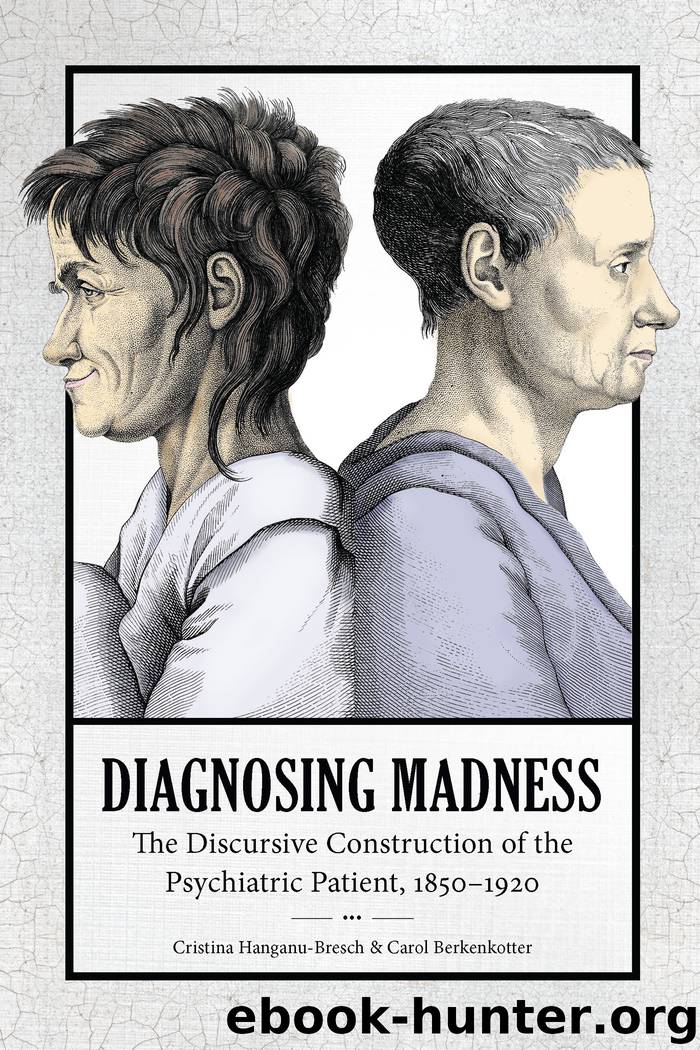Diagnosing Madness by Cristina Hanganu-Bresch;Carol Berkenkotter;

Author:Cristina Hanganu-Bresch;Carol Berkenkotter;
Language: eng
Format: epub
Publisher: University of South Carolina Press
Published: 2019-02-26T16:00:00+00:00
Emplotment, Causality, and Narrative Time
Before turning to the narratives by Merivale and Marshall, we need to explain three concepts that are central to our analysis of, and distinction between, the Ticehurst records (including the case histories) and the former patient narratives. The first of these is the previously mentioned concept of narrative “emplotment,” a rhetorical strategy in which the techniques of backgrounding and foregrounding are but two of many components. The second is the notion of causality, which is essential in determining the order of events in a plot. Finally, the third distinction concerns the contrasting representations of time in the two narratives: asylum time is “metronomic,” whereas the patient’s (and in particular, Merivale’s) representation is “symphonic.” These concepts will shed light on how counter-narratives function rhetorically as oppositional to the linear institutional chronicle24 of a patient’s confinement.
As a concept, emplotment depends on the distinction between story and narrative. For example, there is a distinction between the statements, “The king died, and then the queen died”—a story—and “The king died, and then the queen died of grief”—a plot. This distinction was made by the novelist, E. M. Forster25 and has been elaborated in the following passage by physician Rita Charon: “Emplotment is the action not of the tale but of the teller.… Any sequence of events or actions can be ‘told into’ different plots. Perhaps vertiginous, the realization hits most listeners and readers that there is not a replicable or governing story at all. Depending on the teller’s point of view, intention, and stance, the same set of events can be told so as to make many contradictory plots.”26
The concept of emplotment is closely connected to that of narrative causality. According to Emma Kafalenos, “For historians, for individuals perceiving events in our world, for characters perceiving events in fictional worlds, and for readers (listeners, viewers) of narratives, meaning is an interpretation of the causal relations among a chronologically ordered sequence of events.”27 The causal relationships embedded in the plot thus guide the interpretation, allow the reader to make sense of the narrative, and inform the meaning of a plot. For example, rewriting E. M. Forster’s example as “The king died and then the queen died after being poisoned” forces readers to rethink their interpretation of the story. One sees contradictory plots when comparing Merivale’s and Marshall’s institutional case histories with the two former patients’ personal narratives of their experiences at Ticehurst. Causality is, in effect, reversed in the two types of accounts. For the asylum superintendent—and society at large—it appears that both Merivale and Marshall were confined because they were insane. The patients’ accounts contradict and reverse this causality: they (nearly) became insane because they were confined.
Finally, time and narrative are so closely related as to be mutually defining. For Ricoeur, temporality is “that structure of existence that reaches language in narrativity,” while narrativity is “the language structure that has temporality as its ultimate referent.”28 However, this does not mean that time is similarly realized in the institutional and the patient accounts.
Download
This site does not store any files on its server. We only index and link to content provided by other sites. Please contact the content providers to delete copyright contents if any and email us, we'll remove relevant links or contents immediately.
Periodization Training for Sports by Tudor Bompa(8170)
Why We Sleep: Unlocking the Power of Sleep and Dreams by Matthew Walker(6618)
Paper Towns by Green John(5091)
The Immortal Life of Henrietta Lacks by Rebecca Skloot(4526)
The Sports Rules Book by Human Kinetics(4294)
Dynamic Alignment Through Imagery by Eric Franklin(4118)
ACSM's Complete Guide to Fitness & Health by ACSM(3989)
Kaplan MCAT Organic Chemistry Review: Created for MCAT 2015 (Kaplan Test Prep) by Kaplan(3940)
Introduction to Kinesiology by Shirl J. Hoffman(3726)
Livewired by David Eagleman(3684)
The Death of the Heart by Elizabeth Bowen(3552)
The River of Consciousness by Oliver Sacks(3541)
Alchemy and Alchemists by C. J. S. Thompson(3451)
Bad Pharma by Ben Goldacre(3357)
Descartes' Error by Antonio Damasio(3230)
The Emperor of All Maladies: A Biography of Cancer by Siddhartha Mukherjee(3068)
The Gene: An Intimate History by Siddhartha Mukherjee(3047)
The Fate of Rome: Climate, Disease, and the End of an Empire (The Princeton History of the Ancient World) by Kyle Harper(3003)
Kaplan MCAT Behavioral Sciences Review: Created for MCAT 2015 (Kaplan Test Prep) by Kaplan(2940)
